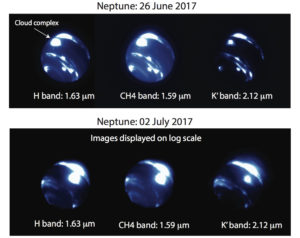Keck Astronomers Surprised by Massive Storm on Neptune

Images of Neptune taken during twilight hours revealed a massive bright storm system near Neptune’s equator, a region where astronomers have never seen a bright cloud. Credit: N. Molter/I. De Pater, Uc Berkeley/C. Alvarez, W. M. Keck Observatory.
Astronomers at W.M. Keck Observatory have captured images of a massive storm system near Neptuneʻs equator, a phenomenon never observed at this region of the far-flung neighbor of Pluto.
“Seeing a storm this bright at such a low latitude is extremely surprising,” said Ned Molter, a graduate student at University of California, Berkeley, who spotted the storm during twilight observation hours at W. M. Keck Observatory on Maunakea. “Normally, this area is really quiet and we only see bright clouds in the mid-latitude bands, so to have such an enormous cloud sitting right at the equator is spectacular.”
The storm is nearly the size of Earth–roughly 9,000 kilometers in length and spanning at least 30 degrees in both latitude and longitude. Molter observed it getting much brighter between June 26 and July 2.

The storm (labeled “cloud complex” above) brightened considerably between June 26 and July 2. Credit: N. Molter/I. De Pater, Uc Berkeley/C. Alvarez, W. M. Keck Observatory.
“Historically, very bright clouds have occasionally been seen on Neptune, but usually at latitudes closer to the poles, around 15 to 60 degrees north or south,” said Molter’s advisor, Professor Imke de Pater of UC Berkeley’s Astronomy Department. “Never before has a cloud been seen at, or so close to the equator, nor has one ever been this bright.”
Neptune is the windiest planet in the solar system, with violent gusts at the equator reaching up to a 1,000 miles per hour. Comparatively, a Category 5 hurricane has wind speeds of 156 miles per hour.
De Pater said that, driven by extremely drastic changes in Neptuneʻs atmosphere, the massive storm cloud could be a seasonal weather event that occurs every few decades.
Molter and De Pater plan to continue observations and data analysis to learn more about the storm and how it evolves over time. Studying Neptuneʻs atmosphere will give astronomers a clearer picture of the planet’s global circulation. In turn, scientists hope to better understand the growing field of exexoplanets. Many of these Earth-like planets have been found to be about the same size as Neptune. Though scientists can calculate their mass and size, little is known about their atmospheres.
Sponsored Content
Comments








